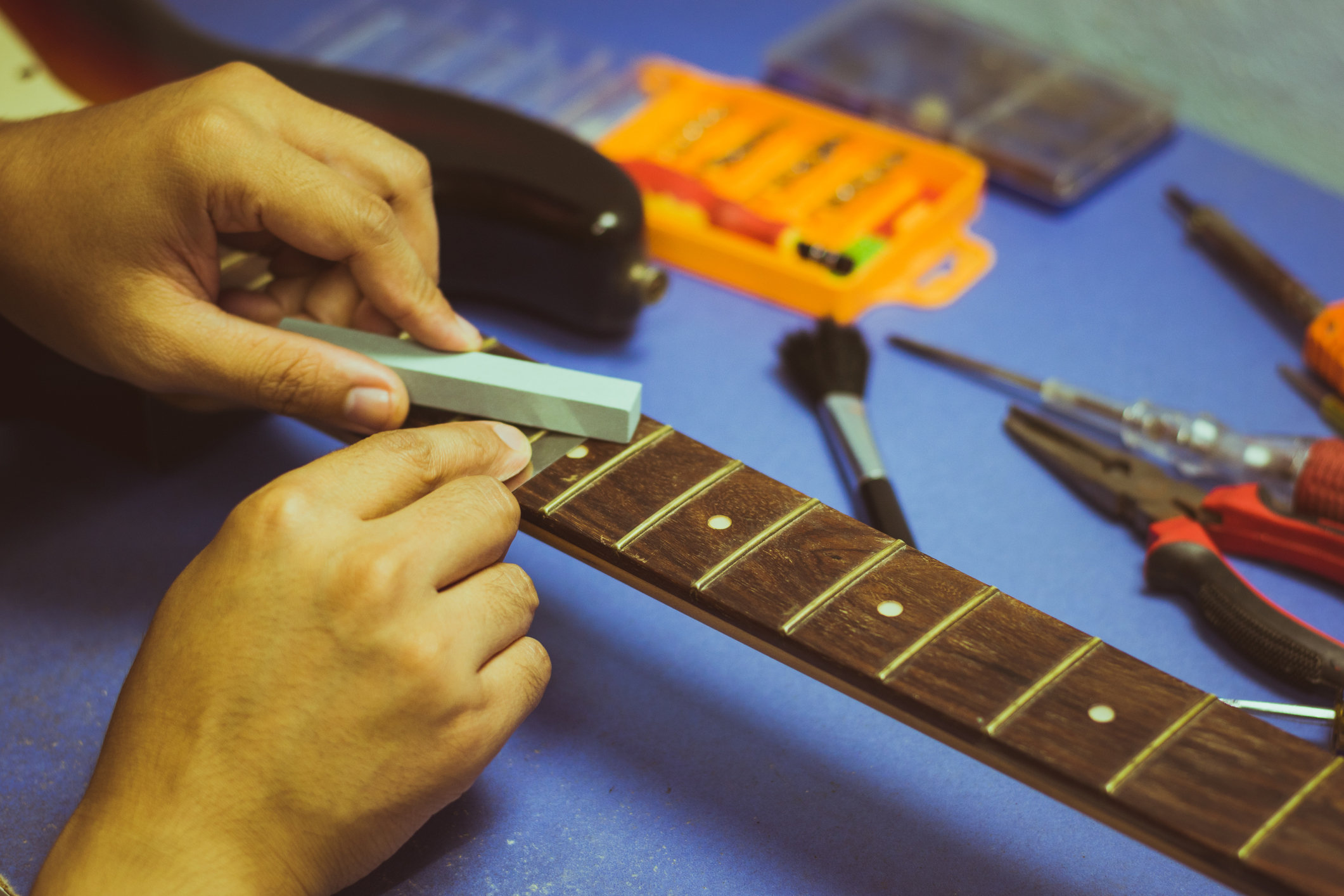-
Posts
49 -
Joined
-
Last visited
-
Days Won
2
Content Type
Profiles
Forums
Gallery
Events
Articles
Blogs
Downloads
Everything posted by Greg Voros
-
Nice job! Respect, --GV
-
Curious to hear if this issue has found a fix? I would guess its a high fret.. -GV
-
Nylon strings get replaced less frequently than bass strings.. And for most bass players - that's saying a lot. I would say depending on how the strings are cared for, I would say twice a year is probably fine. The stretching process takes far too long to replace them more often. Wipe down the strings after each time its played and that will help with the string life. -Greg
-

Fretwire LP Guitar Build Thread
Greg Voros replied to Old Guy's topic in Guitar Care, Repair & Building
Is the Paul completed? -GV -
The action at the nut is relative to the fret height. A generic measurement will not cut it. Hold down each string at the 3rd fret and tap over the first fret. If you have any clearance or gap between the string and the fret, you are good, if you have no gap that would mean the slot is too low and you will likely buzz when the string is played open. There could be a big difference in fret height from guitar to guitar as there are dozens of varying height fret-wire available for luthiers to use; therefore, to make a claim to set it at a certain height as a blanket statement is just inaccurate - when measuring from the board to check nut height. I made mention of this this because some folks do in-fact do it this way. As I read through the notes above I just realized that oldjock made mention of taking that measurement from the first fret. Got it! That can be made to work. However, you can dial it in more precisely than that. I left my commentary in the first paragraph for the sake of making sense. Rock on! I hope this was of help, Greg Voros
-
This is all with the understanding that the neck relief is set to being almost perfectly straight. -GV
-
Classical instrument action height for standard spec is - with the first fret held down (to bypass the nut), measure the gap between the fret and the string at the twelfth fret. The measurement at the high E should be between 5/64ths and 3/32nds and the low E should be between 7/64ths and 2/16ths respectively. To have a classical at standard acoustic spec is high E, 1/16th and Low E 3/32nds. This would be considered low action for a classical and standard for an acoustic flat top guitar. -Greg Voros
-
Different material saddles offer different sounds and over all tone. It really has to do with what makes your guitar sound better considering that guitars can be naturally bright, muddy and everything in between. For most its bone, for some its a high end synthetic material and believe it or not, some tend to sound more balanced with a cheapo plastic nut. -Greg
-

Fretwire LP Guitar Build Thread
Greg Voros replied to Old Guy's topic in Guitar Care, Repair & Building
Great looking top! The curl is nice and deep; good work with the finish so far. -Greg -

Possible to cut a new nut.
Greg Voros replied to joelhunnicutt's topic in Guitar Care, Repair & Building
Good call with having a tech make a new nut. The pre fabricated after-market nuts never truly fit just right. There is no substitution to a person making one to fit the instrument and spacing it properly. -Greg -
Hey folks, This is kind of like asking your mechanic - I hear a funny noise coming from the under the hood, would that be a major repair job? Yes, no, maybe - I don't think anyone can or should answer that question, or answer it accurately at least. With that said, I'm always happy help date, price or evaluate an instrument. You can reach me at Greg@gruhn.com for a pretty quick reply. A few pics help tremendously as well. All my best, Greg Voros
-
In a nutshell, not very much if any.. The saddle material of an acoustic box has the greatest impact on its immediate sound. Truth be told, the bridge pin can be removed if the ball end tucks properly to the bridge-plate - meaning, if you look on the inside with a mirror and the ball is firmly anchored to the plate, you can pull the pin to judge for yourself if there is a difference. -Greg
-

Building: Neck Geometry Over Bridge
Greg Voros replied to Kbore's topic in Guitar Care, Repair & Building
John, I'm curious to see your project. Shoot me a few pics if ya don't mind. Greg@gruhn.com -G -

Fretboard Oil Discussion
Greg Voros replied to Plantsman13's topic in Guitar Care, Repair & Building
Most of the fingerboard products on the market today will do a great job. Some woods are more susceptible to cracking from lack of humidity than others. Some like Mr. Well's Taylor will never have issues - I would thing its because he keeps the instrument in a climate controlled area or lives in a part of the country that has relatively mild seasons. I condition the board and bridge area of an acoustic box at every setup, because it just wont hurt to do so. Greg V. -

New Maton guitar top blemis
Greg Voros replied to JayKayWright's topic in Guitar Care, Repair & Building
Hey folks, My 2 cents... I do believe your arm has polished the flat or matte finish. Or maybe not, either way it sounds like your enjoying the instrument an that's the most important thing. The are flattening agents that can be over-sprayed onto the finish to hide it, but that's likely to be undone after a few weeks of play. I would forget the finish and play the guitar. -Greg -
There is a lot going on here folks, with lots of good advice. Keep this in mind as well - the intonation does not have to be 100% perfect to have a functional guitar. By its nature, a vintage Tele is unable to be intonated using the shared saddle system of 2 strings per saddle. This didn't stop the heaviest Tele players from recording some of the most iconic riffs of all time. with that said +/- 1 or 2 cents wont really hurt things unless you are playing up and down the board utilizing almost every note available - and even so, your fret-wear (crown), and fingering of the notes will probably have a greater impact on your notes and the way they sound. I really hope this was of help, Greg V.
-
Hey there, I'm surprised that it swelled up. I always dissolve my plastics in an even mix of MEK and Acetone. The acetone is fast flashing but has a great bite, the MEK is slower flashing and will continue to melt the plastic even after a few hours. I usually have to drop fill with the plastic slurry twice, the second time would be after the first fill sinks. If its still protruding (balloon), I would take a fine file to it. Best, -Greg
-

Symptoms of a Wet or Dry Guitar
Greg Voros replied to DianeB's topic in Guitar Care, Repair & Building
Hey folks, This is all pretty straight forward stuff. If a top or back crack appears as a result of low humidity, always remember to humidify the instrument prior to gluing up the crack. The most common crack related repair mistake I see is forcing the crack to close up with clamps. Keep in mind, the guitar cracked because of low humidity; If the humidity levels go back up, the crack will almost always close back up on its own. Then I would introduce glue and light clamping to keep it flush will do. I hope this will be of some help in the future, -Greg V. -
Het hey, If you find yourself sawing away for a longer period of time, I would recommend not leaving your bone stock that high prior to cutting and spacing your slots. Maybe you did get a dud set; I've never run into that issue. But what I do know is that after hundreds of nuts, my Japarts files are still ready to roar. As for other makers (distributers), I got tired of buying new sets every couple of years. I got my set about 4-5 years ago and have not been needing files for myself since. To each their own with respect. -Greg Voros
-
Hey Hey, Ok, here it is in a nutshell. In order to accurately take a pickup height measurement you would first hold down the guitars string one at a time on the two E's at the last fret and measure the distance between the string and the pole piece of the pickup. On a single coil pup it should be 3/32nds and a humbucker at 1/16th. That's a great place to set them before plugging in the guitar to hear the balance. If at that point a pickup is hotter than the rest, then that pup would get lowered to match the others. If you raise the pups beyond that point, the magnet is likely to pull on the string somewhat and cause funky fret buzz issues. Cheers, Greg Voros
- 1 reply
-
- 3
-

-

Greg Voros; Answers Your Questions
Greg Voros replied to NeilES335's topic in Guitar Care, Repair & Building
Hey folks, Great advice from all BTW. Ok, the bridge pin issue is pretty straight forward; the pin should fit snug just before the ball top or its collar. Yes, pins are all the same or should be on most guitars but the hole size might be a hair off. I would make a habit of placing the pins in order when restringing the instrument so that they go back the same way they came out. If one happens not to fit right, I would try to swap pins before taking a 3 or 5 degree reamer to it. I hope this was of help, Greg V. -

Restoration of a Vintage Stella 12-string
Greg Voros replied to Dave White's topic in Guitar Care, Repair & Building
Cool video! That's how its done right there. Love it, -Greg -

New Maton guitar top blemis
Greg Voros replied to JayKayWright's topic in Guitar Care, Repair & Building
Hey everyone, I didn't get to read all the great responses to the question; but is it an issue regarding its sheen? from the photo it looks like the arm area is shiny and the rest is more matte. -Greg -

Tuning Machine Peg Hole Size
Greg Voros replied to randyh1953's topic in Guitar Care, Repair & Building
I would check Allparts.com. They have a pretty good selection of easy to swap tuners. Their product support is friendly and knowledgeable as well. Most tuner manufactures have the size that you speak of. -Greg -

Professor Green's Guitar Products
Greg Voros replied to Randy120's topic in Guitar Care, Repair & Building
I would say that most polishes on the market today are pretty darn solid. Prof Green is great because it wouldn't alter sheen; but most folks aren't concerned with that very much on newer instruments. Any and all will do the job. -Greg






